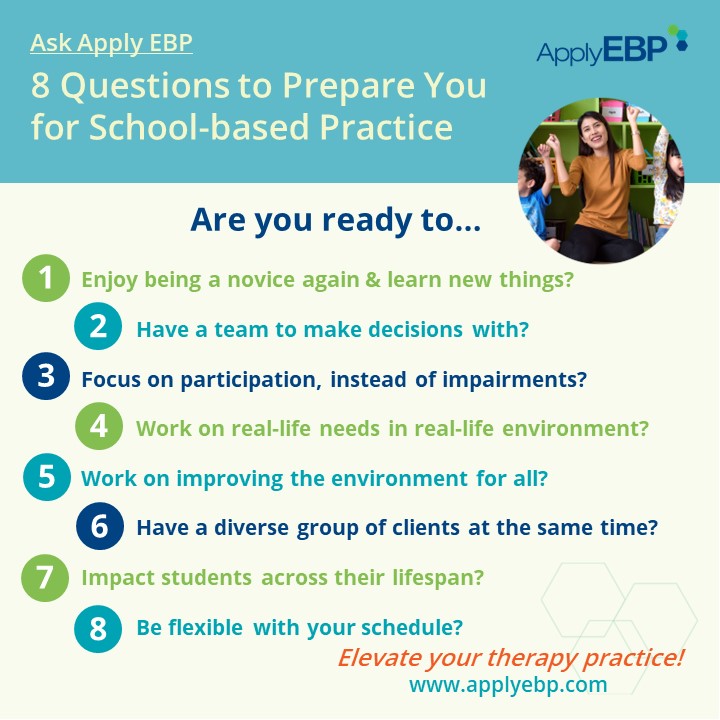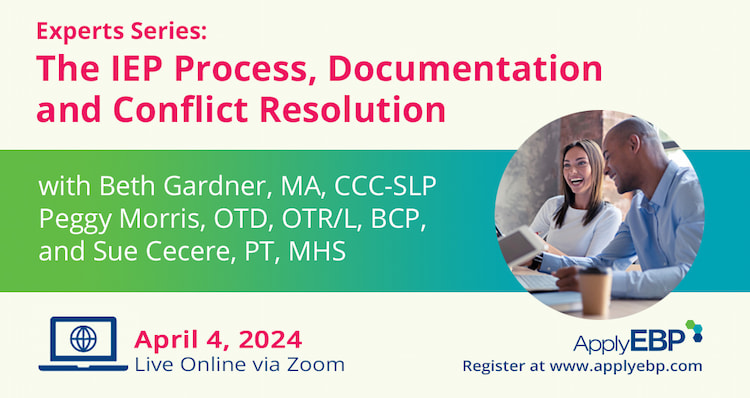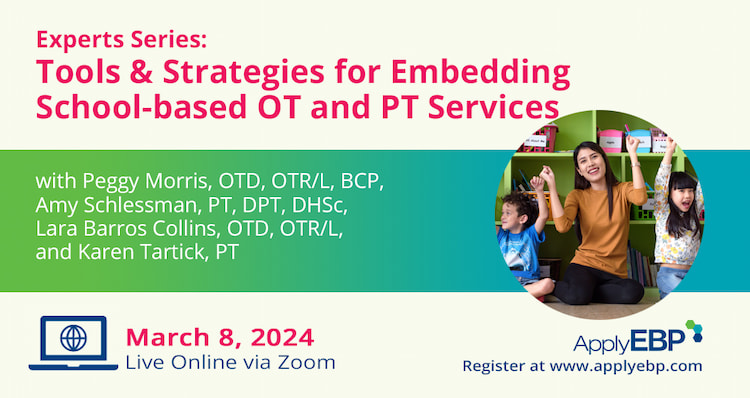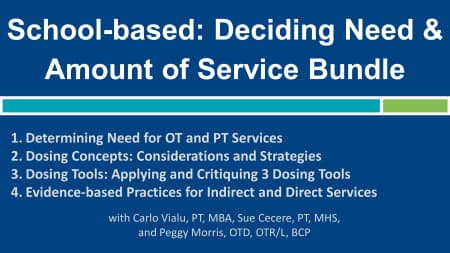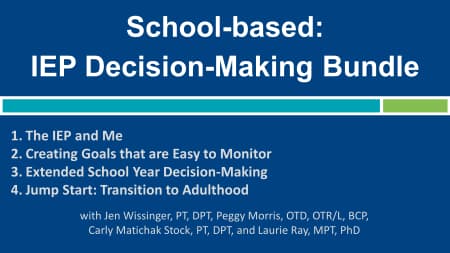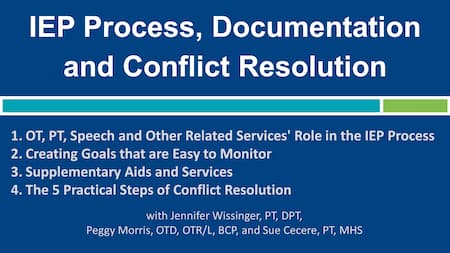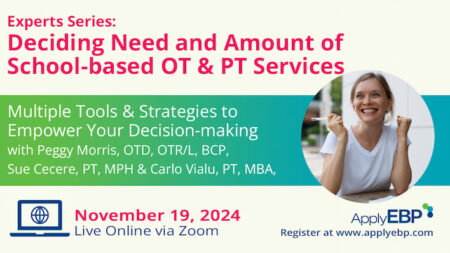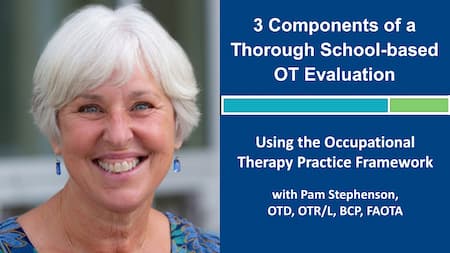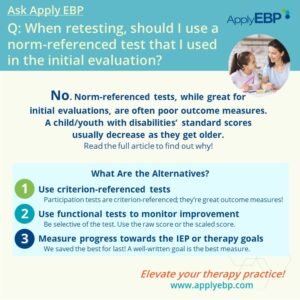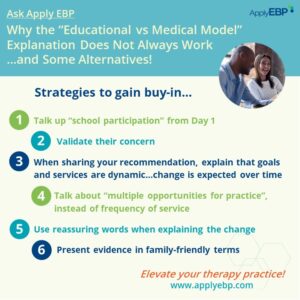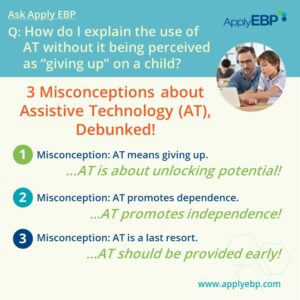Ask Apply EBP
8 Questions to Prepare You for School-based Practice
Q: I am planning a switch to school-based practice, how do I prepare for it?
School-based practice is very different from working in a clinic or hospital. Whether you are thinking of or preparing for a switch, or you just started being school-based practitioner, here are 8 questions that can guide you through the process:
1. Are you ready to enjoy being a novice again and learn new things?
Unfortunately, our professional schooling did not prepare us well to work in the schools. You can see some of the differences in this infographic:
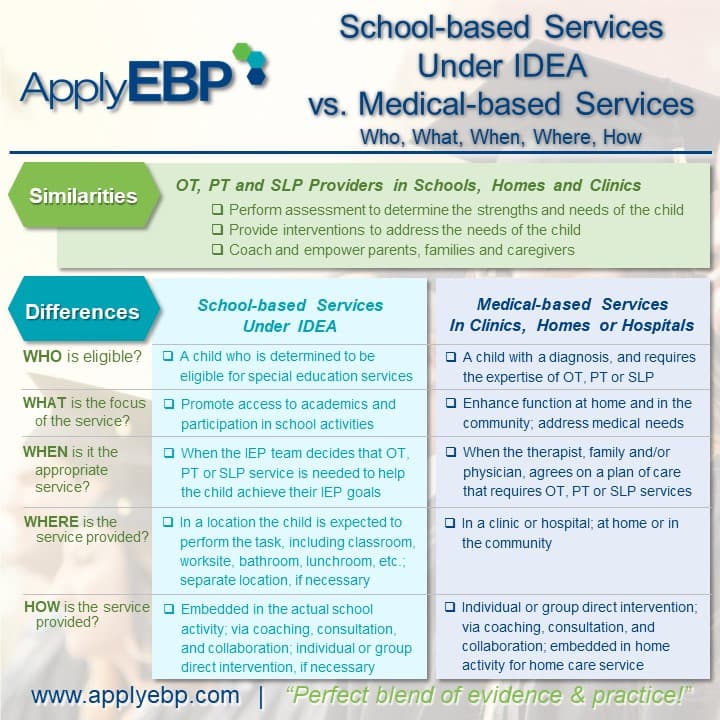
Being new to the practice, you might be tempted to “open your own clinic” in the school and apply a clinic-style approach or to do what the previous therapist was doing.
Before you do either, I would say, this is your great chance to be a novice again, and learn something new. You should take the time to learn the most up-to-date evidence and best practices for working in schools.
-
-
-
- There are lots of rescources from AOTA, APTA and ASHA.
- Read evidence-informed resources.
- Find a mentor, a formal or informal one.
- Join online groups that focus on school-based practice, but keep your eye out whether what is being shared has evidence for or against it.
- Attend courses with the right balance of evidence and practice
- Check out some of what we offer in Apply EBP: live courses, on-demand webinars, or school-based symposiums
-
-
Most importantly, be kind to yourself by giving yourself time to learn, make some mistakes, and work out the kinks of scheduling, working with school staff, and providing services to the students.
2. Are you ready to have a team to make decisions with?
In the clinic or hospital, you, together with the doctor make decisions about the type and amount of service the client will receive. In school-based practice, decisions are made by the team.
For example, school-based OT, PT, and SLP practitioners perform evaluations to inform the team of a student’s strengths and needs, and not necessarily to recommend services. Your evaluation helps the team decide:
-
-
- Whether the child is eligible for special education and related services;
- If so, what goals are needed for the student to benefit from their education;
- And then what primary and related services are needed to address these goals.
-
You can read more about this in our #AskApplyEBP article “Why We Should Not Say “Qualifying for a School-based Related Service“.
Every school team member is expected to share their perspective, input, and suggestions so that the team can come up with the best decision for the student. However, know that there will be times when the team makes a decision that you may not necessarily agree with. There are obvious cons to this, such as the feeling of loss of control or understanding of your profession. But learn from the experience. See if you can advocate for your role with an elevator speech, and explain your recommendations in the future in a way that can get buy-in from others.
But there are also pros! You get more information about the student from multiple perspectives which you can add to your own and make better recommendations. This team decision-making when done well can also avoid having siloed goals that only you would be addressing, and no one else is interested in supporting.
3. Are you ready to focus on participation, instead of impairments?
OT, PT, and Speech are related services that support students with disabilities access and participate in their education. And the sooner they can participate, the better!
How do you change your focus to participation?
-
-
- Assess participation first via contextual observations or standardized participation tools (e.g., SFA Part I) to know the real-life participation need of the student
- Create participation/occupation-based goals
- Provide participation/occupation-based interventions
-
You will learn quickly that many impairments are not malleable or that progress when working on them is too slow to promote participation right away. So, focus on the student’s strengths and the team’s strengths to work around and overcome the student’s challenges in participating with their peers in different school environments.
4. Are you ready to work on real-life needs in real-life environments?
Who needs a therapy room when the whole school is your “therapy room”?!
This is the most rewarding part of school-based practice…
-
-
- You can work with students where their challenges are actually occuring
- There is no need to simulate tasks
- And you get to witness students improve in their real-life function in the school (and not just based on reports)
-
Wondering what evidence-informed strategies you can do in your newly-given “school-wide therapy room”? Read the #AskApplyEBP article “5 Skilled Services We Can Provide When Embedding in the Student’s Real-life Environment.”
5. Are you ready to work on improving the environment for all?
One of our biggest role in the school is to Improve the fit between the student and the environment! Often, in this equation, the environment is more malleable to change. This way they can participate sooner
As you treat the whole school as your “therapy room”, you will notice different aspects of their environment that you can impact.
-
-
- For the physical environment, here are some examples:
- Can you improve the layout of the classroom to promote access?
- Can you make items easy to reach, such as the coat hooks and shelves assigned to the student?
- Can you advocate for physical supports, such as grab bars in the restroom?
- Can you make the playground more accessible?
- Can you improve the chair and desk height to fit the student?
- Don’t forget about the social environment. Sometimes, it can have a bigger influence in the student’s progress than the physical environment.
- Can you train and coach the teacher, paraprofessional, and other school staff about a student’s health condition and how best to support them?
- Can you work with the teacher to co-teach a peer education session for the whole class?
- Can you discuss with the team to ensure that strategies provided by different school staff are consistent? Multiple, contradicting instructions from different adults is confusing for the student.
- For the physical environment, here are some examples:
-
You can also try the School Participation Questionnaire (SPQ), to identify aspects of the environment that can be improved. It’s a free test!
As a big bonus, improving the environment benefits not just your client, but every student in that class or in the whole school!
6. Are you ready to have a diverse group of clients at the same time?
Your client is not just the child, it can also be the teacher, other school staff and the parent, guardian or family, or even the whole school.
They are all big influences on the student’s education and post-education outcomes! By working with them, you can increase the student’s opportunities for skill practice and, therefore, the development of their skills! It’s like multiplying your impact times the number of staff you coach.
Take the time to learn how to coach the school staff so they can come up with great ideas to support the child. As Jen Wissinger, PT, DPT, this is very different from “couching” where you sit them down and tell them what they need to do. Instead, consider each other as co-experts when it comes to the child’s needs and guide them to explore strategies that they think can easily be implemented.
When you are ready to level up, learn about Multi-Tiered System of Supports, and how you can support its implementation. This way you impact not just one student, but a whole class, or even the whole school.
7. Are you ready to impact students across their lifespan?
Many disabilities do not disappear. Which means our clients will face different types of challenges as they get older. So think episodes of care!
In their younger years, you may work with them to better their participation in class, gym, mealtime, toileting, or recess. But always keep the end-goal in mind for our students, which is “to prepare them for further education, employment, and independent living”(IDEA §300.1). So make sure that everything you is helping them not just for right now, but you are buidling skills for their future!
In middle and high school, you may need to work with them again, this time, on their transition goals.
-
-
- Can you be involved in their job training by training them on new skills, or exploring assistive devices that may help them at work?
- Can you support independent living skills, such as doing chores, preparing a meal, or money management?
- Can you impact their community participation, such as use of public transportation, access community resources, chores, or figuring out a recreation or leisure activity that is right for them?
-
8. Are you ready to be flexible with your schedule?
In the clinic, you may have an admin that schedules sessions based on your availability;. Wasn’t that nice?!
In school, you work to create a schedule that suits the needs of the students in your workload. Scheduling is more of an art than a science.
Here’s a good rule of thumb:
-
-
- Start by scheduling your embedded services so you are there when and where the student needs your help.
- Do you have any out-of-class services to provide? Schedule them next. Work with the teacher to find the least disruptive time for these services
- Next, set aside time for your consult services. Consider what’s best for the teacher, the student, or whoever you are consulting with. Think about whether this consultation will be via a video or phone call, or do you need to travel to be face-to-face.
- Then carve out time for other school responsibilities, such as documentation, meetings, phone calls to families or outside services, make-up services, adjusting equipment, doing evaluations or screenings, participating in MTSS and others. Mark those on your calendar as such so others understand your different roles and value in the school.
-
Then be flexible throughout the year, month, or even within a day, as this may change based on the needs of the students, a schedule change in class (e.g., field trip, fire drills), or other reasons. Don’t beat yourself up when you can’t follow the schedule. Join their field trips or fire drills, or you may need to switch your schedule around. There will be days when you just have to go with the flow!
Final Words
School-based practice is a big shift in perspective and approach to our services. Don’t be overwhelmed. You don’t need to be ready to do all of the above right away! Just know that they are all part of being a school-based therapist. Tackle them one at a time, starting with what you think is the easiest or what you need to do right away.
And I will end this article with what I started with…
Be kind to yourself…be a novice and allow yourself time to learn and be the best school-based therapist that you can be!
Now, go for it! Answer the questions above, and if you have other suggestions, add them to the comment below. Check out these courses that you may find helpful in preparting you for school-based practice:
Or these on-demand webinars
Find More Answers to Your Questions in Our...
Featured School
Symposium
6th Online School-based OT and PT Symposium - On-demand Version
- Watch and re-watch on your own time
- On-Demand Version
- OTs, OTAs, PTs and PTAs
- $399-449
Featured Live
Workshop
Deciding Need & Amount of School-based OT/PT
- November 19, 2024, 8:30 am - 3:30 pm Eastern Time
- Online via Zoom
- OTs, OTAs, PTs and PTAs
- $199-249
Featured On-Demand
Webinar
3 Components of a Thorough School-based OT Evaluation
Featured Webinar
Bundle
The IEP Process, Documentation & Conflict Resolution Bundle
Have a question?
Submit here…
*Clicking submit will send your question directly to our email inbox. Your name and email will let us know that your submission is real (not spam). We will not include these in our posts, unless you tell us to include your name. Please read our privacy policy here.
All infographics and videos on www.applyebp.com are intellectual properties of Apply EBP, LLC
You may use the infographics and videos for free for any non-commercial, educational purposes. Please cite the source as “Apply EBP, LLC” and a link to the source article. If you plan to use any infographic or video for commercial purposes (i.e., for profit), please email Carlo@applyebp.com to obtain a written permission. Permission can be granted on a case-by-case basis.

